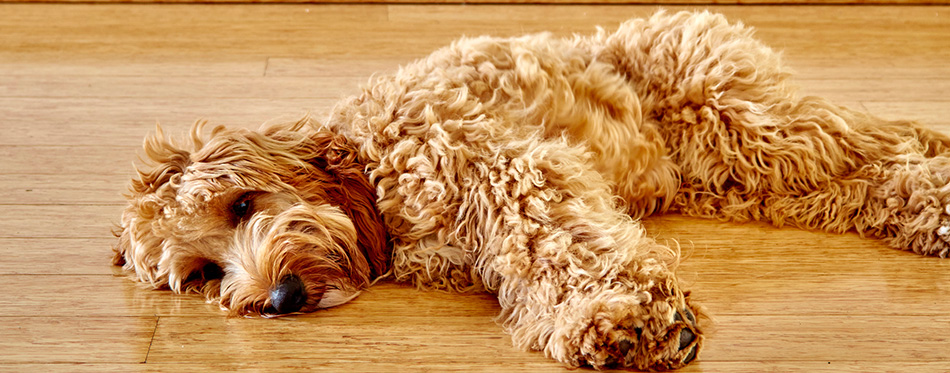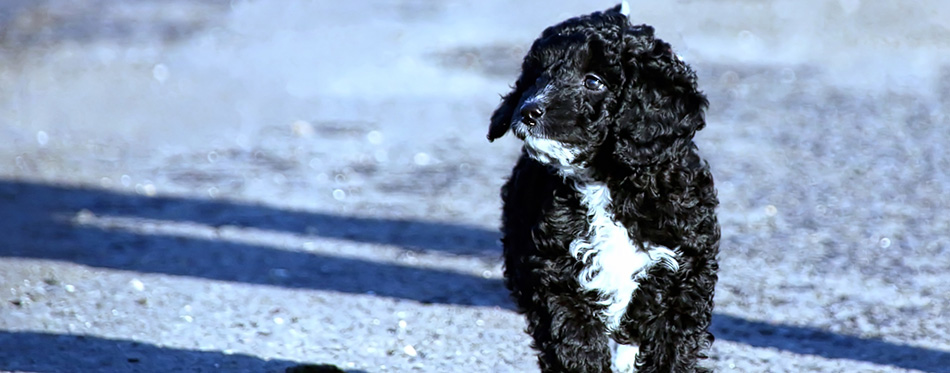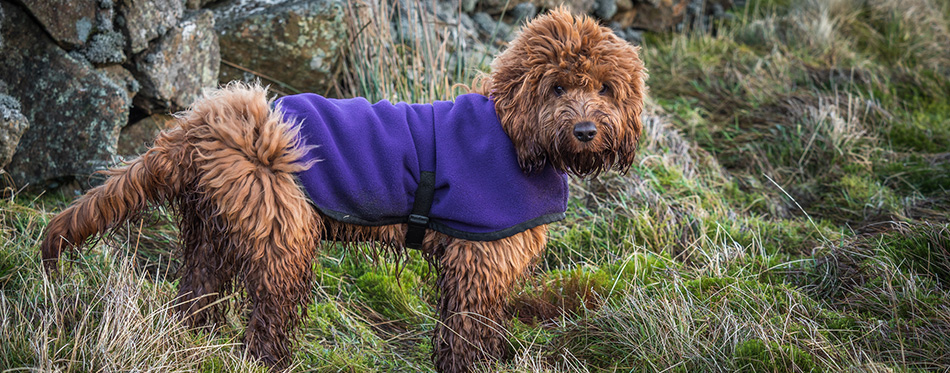Nowadays, designer dog breeds can be found everywhere and are arguably more popular than traditional pure breeds in some instances. Although designer breeds are still growing in popularity, the Cockapoo might just be the most famous of them all as it was the first! This adorable and lovable little pup isn’t just popular because it’s the oldest of its kind. No, the Cockapoo also has a reputation for being easy to train, caring and the epitome of “man’s [or woman’s] best friend.”
In this article we’re going to look at some of the most important aspects of Cockapoo care you’ll need to know before buying/adopting one. We’ll also cover some top facts which you really ought to know about this wonderful pooch. So, whether you’re simply in love with this beautiful crossbreed or you’re considering buying or adopting one, you’ll find some fascinating facts below!

History of the Cockapoo
Some dog breeds have incredibly long histories spanning centuries or even millennia! The Cockapoo, however, has a much shorter history, reaching back to just the 1960s. This beautiful breed was made by crossing the Cocker Spaniel and the Poodle, creating a unique looking dog which has all the admirable qualities of its parental breeds. Since the Cockapoo is a cross breed, it isn’t recognized by any Kennel Clubs or Associations but this might change in the future. Due to the constant growing popularity for the Cockapoo, some groups and registries have been set up in an attempt to create a breed standard. So, while the breed isn’t currently recognized, this is likely to change in the future.
Quick Facts About the Cockapoo
- The Cockapoo is known by a few different names. Cockapoodle, Cock-a-Poo, Spoodle, Cockerdoodle or Cockerpoo are all synonymous of the wonderful Cockapoo!
- Typically, the Cockapoo size is somewhere between 10 to 15 inches tall during adulthood and they weigh around 12 to 24 pounds.
- The Cockapoo comes in many shapes and sizes and, while there is an average height and weight, not all doggos conform to this standard. Even through selective breeding it’s possible to get a mini Cockapoo or one that is larger than usual. These differences are what make each dog unique.
- The Cockapoo dog coat comes in a huge variety of colors and combinations. Black, white, cream, beige, brown, tan, brindle, red, sable and merle are among some of the most common colors for the Cockapoo coat. They can also come in a combination of these colors or shades of them.
- The Cockapoo coat varies a lot from animal from to animal and is typically somewhere between its parents’ coats. On average, Cockapoos have a medium to long coat length which is usually wavy or curly. It also has a tendency to grow rather quickly so it’s necessary to frequently brush your pooch’s coat to prevent matting and a buildup of debris and dirt.
- Cockapoo poodle mixes are one of only a few mixes found using this breed. Since it is widely believed to perfect, most Cockapoo dogs are bred with others of the same breed in an attempt to create a breed standard.
Things You Should Know
Now that you’ve learned some of the top fascinating facts about this beautiful breed, it’s time to take a more in-depth look at essential aspects of Cockapoo dog care. Before we break down each aspect, here are some answers to the most commonly asked questions about the Cockerdoodle.
- Is the Cockerpoo hypoallergenic?
Yes! So, if you or a family member usually have reactions animal hair or fur, you should be fine with this precious pup. Their hypoallergenic nature combined with their minimal shedding makes them the perfect companion to most pet parents, particularly to those with allergies.
- Is Cockapoo shedding normal?
No! The Cockapoo doesn’t typically shed very much at all. This is great for pet parents who desperately want Cockapoo puppies but don’t have time to constantly clean and vacuum their shedding hair every other day.
Health
The Cockapoo doesn’t have any breed-specific medical conditions however, it can inherit conditions found in either parent breed. Here are a few medical problems which arise in both parental breeds as well as other dogs of a similar size and weight.
- Patellar Luxation – This condition is the result of a malformed kneecap which dislocates from its natural position, causing it to float in place. Hence the other name for this condition- floating kneecap syndrome. Since the condition is common among many dog breeds, it isn’t an immediate cause for concern. In fact, in most cases, no medical intervention is required. However, in particularly severe cases, some dogs may require operations to correct the kneecap placement.
- Progressive Retinal Atrophy – This condition affects many dog breeds and can cause several eye problems. The conditions can vary greatly in severity from eye pain to cataracts or even blindness. It’s also worth noting that Progressive Retinal Atrophy (PRA) deteriorates much faster in younger dogs. Medical checks and thorough eye cleaning can greatly reduce the risks of the condition in pups. However, it can be avoided entirely through selective breeding.
If the Cockapoo dog is raised in a good home with lots of care and attention and their needs are met, they can live many long and happy years. To be precise, the cockapoo lifespan is between 12 to 18 years. Furthermore, the main medical conditions which can be found in this breed (such as the ones previously mentioned) can be avoided by careful and selective breeding. For this reason, it’s important to only buy or adopt a Cockapoo from a trusted breeder and ensure it (and its parents) have had medical exams to catch any hereditary conditions.

Training
Since the Cockerpoo is a sociable and loving dog, they love learning new tricks and skills to please their owners. They are usually easy to train, just like their parent breeds. Using a thorough and rewarding training program is the best way to teach your new pup essential skills. You should focus on teaching one skill at a time while using positive reinforcement to achieve the desired behavior. Using tasty dog treats, toys or having a fun play session with your pup are some of the best ways to reward them for successfully learning and performing a new skill.
Crate training can also be used to help a Cockapoo adapt to its new environment and to ensure it feels comfortable in its new home. Just be sure not to leave your precious pooch alone and/or in its crate for too long as the Cockapoo breed can experience separation anxiety when removed from its owner’s company for a long period of time. Other than during the night when the Cockapoo is sleeping, they shouldn’t be left in their crate for longer than a few hours at a time. However, crate training can be a great way of training a pooch whether you live in a large house or a small apartment. Take a look at our review of dog crates for more info.
Exercise
Exercise is a crucial aspect of dog care that varies a huge amount from dog to dog. While some dogs might need hours of intense exercise, others simply need a short play session outside every day. The Cockapoo, thankfully, is a happy medium. Some Cockerpoos only need around 15 minutes of exercise per day, particularly if they’re young, old or if they have some form of medical condition. However, others will need up to an hour when they are fully grown and if they’re particularly athletic. The average exercise time will change as the Cockapoo puppies grow up so you might need to seek professional advice from your vet to keep you right.
Nutrition
It can be difficult to recommend a dog’s diet since this entirely depends on the specific animal. Diet also depends on several factors such as the dog’s weight, height, its ability to exercise and any medical conditions which might be present. However, you can’t go wrong with a balanced diet which is packed with nutrients and animal protein. Cockapoo dogs should be fed twice a day, with one meal being in the morning and the second in the evening. The daily recommended food should be evenly divided between these mealtimes with a few treats dispersed throughout the day to reward good behavior or when playing with your pup. If your pup begins to lose or gain weight, it could be that their diet and exercise isn’t adequately matched. Reducing the amount of exercise and giving more food can help to stop sudden weight loss while less food and more exercise will help to lose any additional or unhealthy weight.
If your dog seems to lose or gain weight without reason and it can’t be fixed by lifestyle or diet changes, it could indicate that a medical condition is to blame. In this situation you should inform the vet immediately to reduce risk and to have the best chance of a quick and accurate diagnosis.
Check out our guides on Dog Food For Cocker Spaniels, Wet Dog Food and Dry Dog Food for more info.
Grooming
Thankfully, the Cockapoo’s grooming needs are quite simple, just like any other dog with a similar appearance. There are a few essential aspects of grooming which you’ll need to carry out regularly to keep your pup clean and healthy. Here are the most important.
As we’ve mentioned, the Cockapoo has a medium to long coat which is wavy or curly. Because of this, it can become matted or dirty quite easily so frequent grooming is essential. Brushing daily or every two days is the best way to remove dirt, stop matting and generally keep your doggo’s coat in good shape. The Cockapoo’s hair also grows quickly so you’ll need to have their hair trimmed more regularly than some other dogs. As a result of their rapid hair growth, you’ll also need to have your dog’s ear hair trimmed. Ear hair should be trimmed to keep it tidy and to help prevent ear infections which are common in dogs with long hair. Trimmed ear hair is essential for preventing dirt particles from gathering and becoming lodged in the ear which can cause a variety of ear and hearing problems.
This leads us directly to the next important aspect of grooming – ear cleaning. Dog ear cleaning (and eye cleaning) should be carried out whenever necessary. That might mean every day for some dogs or just a couple of times per week for others. You’ll need to use a damp cloth to gently brush any visible dirt or debris away from the area. When cleaning a dog’s ears, you should also use a special solution for breaking down wax buildup. This can be purchased at most good supermarkets, pet stores or from the vet.
The last essential aspect of dog care which we need to cover is nail trimming. This is often overlooked but is crucial to get right to ensure your pup isn’t in pain when they’re playing or exercising. This is often the most challenging aspect of grooming for pet parents but with some patience, time and treats, you’ll get there. Every dog is different so some pups’ nails will need trimmed every couple of weeks, while others might do with a short trim once per month. This aspect is all about trial and error but if you’re really unsure, simply ask your vet for advice tailored to your dog’s specific needs.
Check out some of our dog grooming guides, such as dog shedding brush, dog ear cleaner, dog shampoo, dog bathtub, dog thinning shears, dog grooming gloves, puppy shampoos and dog nail clippers.

Temperament
The Cockapoo temperament is arguably one of the best aspects of this dog. It is a loving and affectionate companion that likes to have lots of fun and play. The Cockapoo also loves interacting with its favorite humans and other pets which makes it great for family life. Of course, if you’re introducing your Cockapoo to small children or other pets, you should ensure they are well-behaved and supervised. Even the most well-behaved children and pets can make mistakes by playing too rough and causing accidents. Socializing and training your Cockerpoo while it’s young is the best way to ensure they grow into a happy and healthy adult doggo.
You May Also Like Our Guides On: Maltipoo, Havapoo, Shih-Poo, Sheepadoodle and Miniature Goldendoodle.
Source:
- The Cockapoo – Cocker Spaniel Toy Poodle Mix – Animal Corner

